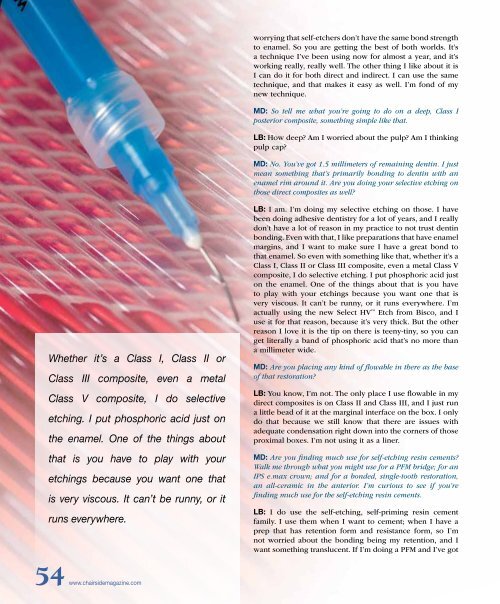Chairside - Glidewell Dental Labs
Chairside - Glidewell Dental Labs
Chairside - Glidewell Dental Labs
Create successful ePaper yourself
Turn your PDF publications into a flip-book with our unique Google optimized e-Paper software.
worrying that self-etchers don’t have the same bond strength<br />
to enamel. So you are getting the best of both worlds. It’s<br />
a technique I’ve been using now for almost a year, and it’s<br />
working really, really well. The other thing I like about it is<br />
I can do it for both direct and indirect. I can use the same<br />
technique, and that makes it easy as well. I’m fond of my<br />
new technique.<br />
MD: So tell me what you’re going to do on a deep, Class I<br />
posterior composite, something simple like that.<br />
LB: How deep? Am I worried about the pulp? Am I thinking<br />
pulp cap?<br />
MD: No. You’ve got 1.5 millimeters of remaining dentin. I just<br />
mean something that’s primarily bonding to dentin with an<br />
enamel rim around it. Are you doing your selective etching on<br />
those direct composites as well?<br />
Whether it’s a Class I, Class II or<br />
Class III composite, even a metal<br />
Class V composite, I do selective<br />
etching. I put phosphoric acid just on<br />
the enamel. One of the things about<br />
that is you have to play with your<br />
etchings because you want one that<br />
is very viscous. It can’t be runny, or it<br />
runs everywhere.<br />
LB: I am. I’m doing my selective etching on those. I have<br />
been doing adhesive dentistry for a lot of years, and I really<br />
don’t have a lot of reason in my practice to not trust dentin<br />
bonding. Even with that, I like preparations that have enamel<br />
margins, and I want to make sure I have a great bond to<br />
that enamel. So even with something like that, whether it’s a<br />
Class I, Class II or Class III composite, even a metal Class V<br />
composite, I do selective etching. I put phosphoric acid just<br />
on the enamel. One of the things about that is you have<br />
to play with your etchings because you want one that is<br />
very viscous. It can’t be runny, or it runs everywhere. I’m<br />
actually using the new Select HV Etch from Bisco, and I<br />
use it for that reason, because it’s very thick. But the other<br />
reason I love it is the tip on there is teeny-tiny, so you can<br />
get literally a band of phosphoric acid that’s no more than<br />
a millimeter wide.<br />
MD: Are you placing any kind of flowable in there as the base<br />
of that restoration?<br />
LB: You know, I’m not. The only place I use flowable in my<br />
direct composites is on Class II and Class III, and I just run<br />
a little bead of it at the marginal interface on the box. I only<br />
do that because we still know that there are issues with<br />
adequate condensation right down into the corners of those<br />
proximal boxes. I’m not using it as a liner.<br />
MD: Are you finding much use for self-etching resin cements?<br />
Walk me through what you might use for a PFM bridge; for an<br />
IPS e.max crown; and for a bonded, single-tooth restoration,<br />
an all-ceramic in the anterior. I’m curious to see if you’re<br />
finding much use for the self-etching resin cements.<br />
LB: I do use the self-etching, self-priming resin cement<br />
family. I use them when I want to cement; when I have a<br />
prep that has retention form and resistance form, so I’m<br />
not worried about the bonding being my retention, and I<br />
want something translucent. If I’m doing a PFM and I’ve got<br />
54 www.chairsidemagazine.com
















